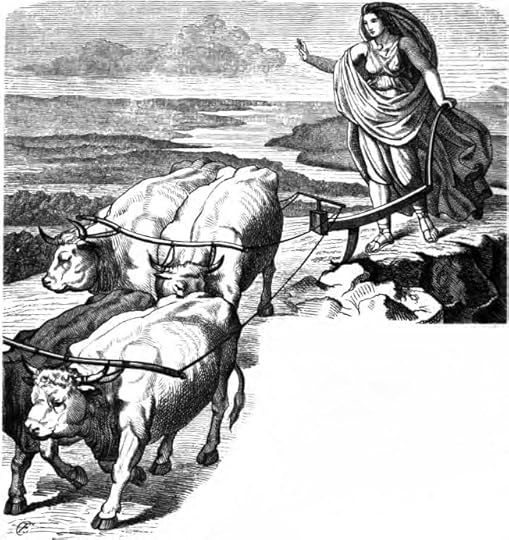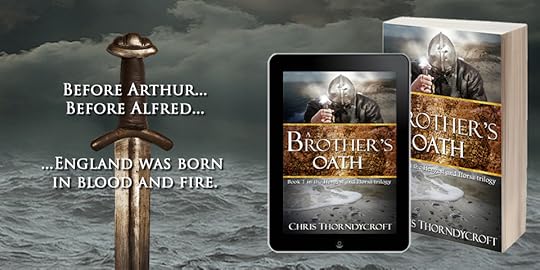Giving Anglo-Saxon poetry a go
What is an Anglo-Saxon story without a little alliterative verse? In my novel A Brother’s Oath (book 1 in the Hengest and Horsa Trilogy), I have some exposition given in the form of a poem written in the style of Beowulf. The scene is a smoky mead hall where Horsa and his companions have sought shelter for the night. As the marsh mist descends around the hall, the chieftain’s scop (a poet) tells them a creepy story about the ancient cult of the Wanes (Germanic fertility gods cognate with the Norse Vanir).
These lands hold a lake, lost to time,
Formed in the beginning, when the world was barely born.
Around its still depths the settlers dwelled,
Wane-worshippers they were, wiccan and wise,
And from whence they came none now know.
The mere-dweller was their matron; a goddess of guile,
A queen of the land from long distant legend,
In shadow-haunted woods was she worshipped,
And in moonlit circles, her slaves were sacrificed,
And blood ran red on the runestones to her name.
Her name was Gefion; a goddess of giving,
And in her image an idol, iridescent was made,
Of glittering gold, gleaming and smooth,
With eyes of jade and studded with gems,
No finer fashioned idol was ever forged.
Rome rose and fell and the rumours remained,
Of the Wane-goddess and her worshippers,
By the shores of the lake, in luxurious wealth,
Denying the new gods, no glory to them,
Of Woden and Frige, frightened were they not,
Nor of Thunor and Tiw, truth they already knew.
The Sons of Woden, heard whispers of the Wanes,
And set out with shields, and spears sharpened bright,
Of greed they thought, to gain glory for their gods,
And pillage and plunder, to fill their purses.
Red ran the lake, as the looters found victory,
Over the children of Gefion who were butchered and slain.
The golden statue was stolen away,
A goddess defeated and her devout left dead.
Around the idol, the ill-meant victors revelled,
Until mead and merriment, muddled their minds,
And they slept, strewn in the statue’s shadow.
But dawn broke over barbarous ruin,
The warriors’ corpses were cloven and clawed.
None had awoken during the slaughter, and the stolen statue,
Was stolen once more.
The women wept for Woden’s brave sons,
And the missing idol spoke of mischief and malice.
None knew who had slaughtered their stout sons,
And the hills hide their hideous secrets.
No names give the nighted fens,
And the forests feed no answers to the fearful.
Gefion and the Wanes are forgotten but by the few,
But some say they have seen strange sights on the moors,
Of troll-shapes in the mist, murderous and monstrous,
And strange lights beneath lakes at night,
In league with the lake-dweller they liken these things,
And the Wane-queen’s vengeance will never wilt,
Nor will the shape that haunts these lands.
 Gefjun Plows Zealand with her Oxen (1882) by Karl Ehrenberg
Gefjun Plows Zealand with her Oxen (1882) by Karl EhrenbergThe Roman historian Tacitus tells us of a goddess called Nerthus who was kept in a sacred grove on an island in the northern sea. Referred to as ‘Mother Earth’, Nerthus rode a wagon pulled by cows and traveled among the populace who feasted and made merry in her wake. The goddess (possibly represented by a statue) was then cleansed in a sacred lake and her slaves were then drowned.
Nerthus appears to be a Latinisation of Njorthr; a god of the sea attested to in later Norse literature. Why give a goddess a male name? One theory is that we are dealing with a set of twin deities akin to Freyr and Freyja (who were Vanir and the offspring of Njorthr according to Snorri Sturluson’s Prose Edda). Who then was the female counterpart to Nerthus? One candidate might be Gefion, a fertility goddess associated with ploughing whose name possibly means ‘the giving one’ and appears to be mentioned several times in Beowulf. The Prose Edda and Heimskringla both credit Gefion as creating the Danish island of Zealand by gouging out a piece of Sweden with her plough and dumping it into the sea. Some theories have interpreted the battle between Beowulf and Grendel’s mother in the famous Anglo-Saxon poem as an allegory for the overthrow of an older fertility cult by a younger cult of war gods represented by Woden, Thunor and their fellow ‘Ese’ (Aesir) who were known to have fought a war against the Wanes (Vanir).




